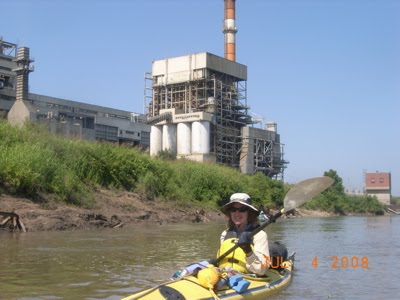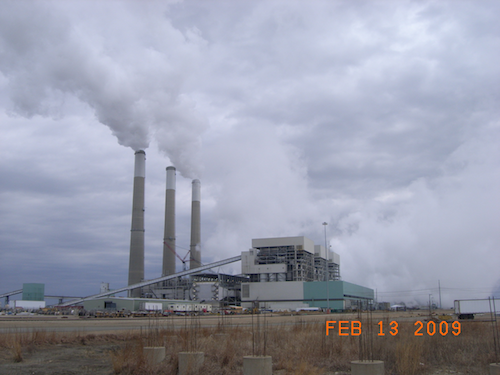 The big energy producers along the Kansas River, coal-fired plants, withdraw a lot of water from the river. A plant the size of the Lawrence Energy Center (539 MW capacity; pictured below) draws almost 1.6 billion gallons of water a year. Thermoelectric power plants are second only to irrigation for the largest amount of water withdrawn nationwide according to the US Department of Energy. And while much of the water withdrawn by those plants is eventually returned to the river, The Union of Concerned Scientists estimates that:
The big energy producers along the Kansas River, coal-fired plants, withdraw a lot of water from the river. A plant the size of the Lawrence Energy Center (539 MW capacity; pictured below) draws almost 1.6 billion gallons of water a year. Thermoelectric power plants are second only to irrigation for the largest amount of water withdrawn nationwide according to the US Department of Energy. And while much of the water withdrawn by those plants is eventually returned to the river, The Union of Concerned Scientists estimates that:
When this water is drawn into the power plant, 21 million fish eggs, fish larvae, and juvenile fish may also come along with it… In addition, EPA estimates that up to 1.5 million adult fish a year may become trapped against the intake structures. Many of these fish are injured or die in the process.
Not only is the water returned to the river altered by the removal and injury of aquatic life, it is also contaminated by a number of pollutants. Wastewater discharged from electrical generating plants into the river is regulated as a point source by the National Pollutant Discharge Elimination System (NPDES), under the authority of the Kansas Department of Health and Environment. The wasterwater is also warmer than the river since coal-fired plants may heat the water to a higher temperature than the river. This “heat” can have a major impact on aquatic life and is also regulated by KDHE.
Another route by which electrical generating plants impact the quality of the water in the Kansas River is by discharging pollutants into the air that can settle back to earth and wash into the river. Air borne pollutants from coal-fired plants are a major source of atmospheric mercury, which comes from combustion of coal. Atmospheric mercury accumulates in lakes and rivers, where it enters the food chain. Higher concentrations of mercury have been found in fish caught near coal-fired plants. Large predatory fish, like largemouth bass, striped bass, and walleye have been found to have the highest levels of mercury, because mercury concentrates as you move up the food chain. The US Environmental Protection Agency has issued a warning for mercury in fish. You can read about this and other health advisories on our Fish Advisory Page.
 When an electrical generating plant burns coal it produces fly ash, consisting of fine particles that “fly” up the smokestack and have to be trapped, and heavier bottom ash. Both of these combustion byproducts are stored in landfills, either together as in the TVA landfill, or separately as in the Westar landfills in Kansas.
When an electrical generating plant burns coal it produces fly ash, consisting of fine particles that “fly” up the smokestack and have to be trapped, and heavier bottom ash. Both of these combustion byproducts are stored in landfills, either together as in the TVA landfill, or separately as in the Westar landfills in Kansas.
As reported by SourceWatch, the coal ash produced by coal-fired plants in the U.S. contains large quantities of toxic metals, including 44 tons of mercury, 4601 tons of arsenic, 970 tons of beryllium, 496 tons of cadmium, 6275 tons of chromium, 6533 tons of nickel, and 1305 tons of selenium.
In terms of our local situation, the Jeffrey Energy Center is ranked 99th out of the top 100 most polluting power plants for storage of coal combustion byproducts; during 2006 Jeffrey Energy Center released 190,417 pounds into surface impoundments.
Our situation in Kansas was summed up by former Governor Kathleen Sebelius in her column in the Wichita Eagle: “In Kansas, our energy portfolio is unbalanced and too dependent on coal. While the nation receives only half of its energy from coal, in Kansas it is 75 percent. This makes us 10th in the nation in per capita carbon dioxide emissions, and extremely vulnerable to the costs and penalties of imminent federal regulation.” In recent years Kansas has worked to increase it’s energy infrastructure with wind energy, improved hydropower, and other practices, but Coal is still the primary source of energy for our state.
